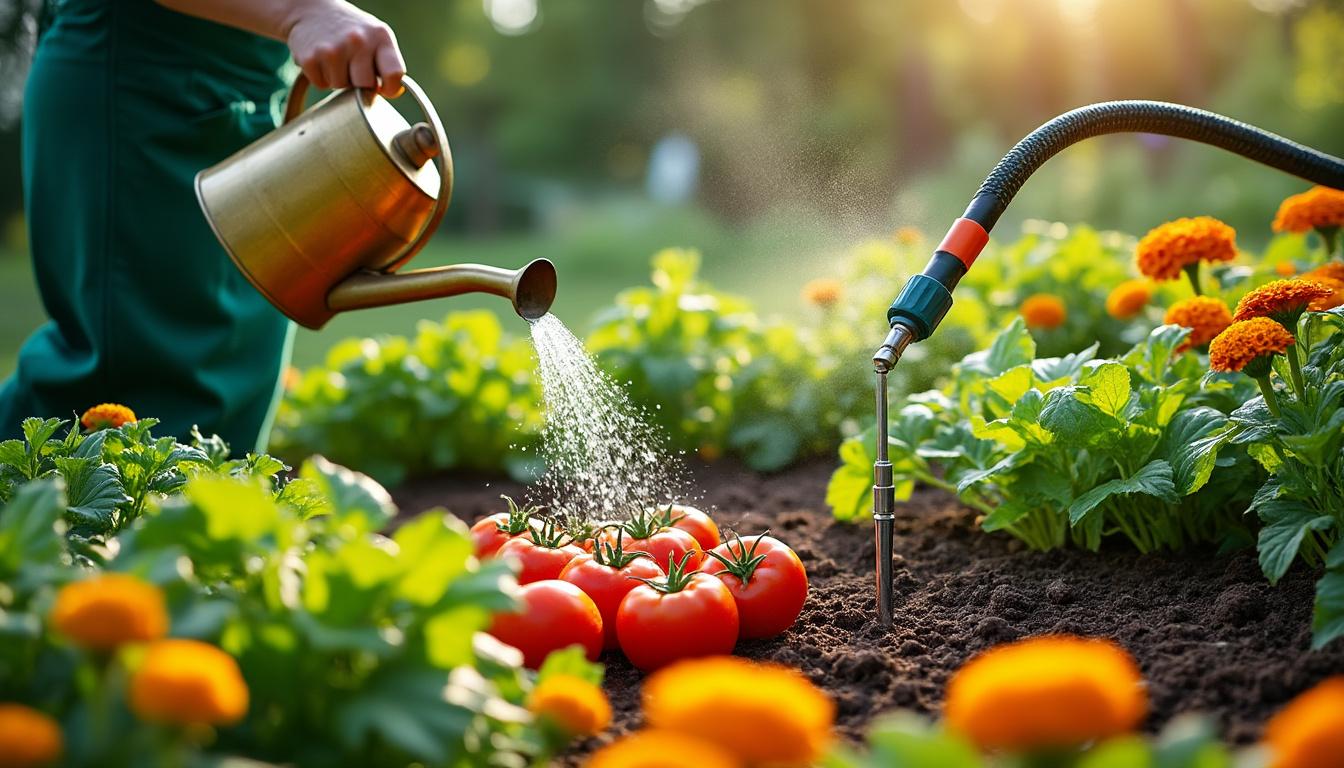Gardening in 2025 demands precision and care, particularly when it comes to watering practices that fuel plant vitality and sustained growth. The secret to flourishing gardens lies in combining effective techniques with innovations such as drip irrigation and moisture meters, while considering soil type and plant needs. Equipped with thoughtful watering strategies and smart tools from brands like Miracle-Gro, Rain Bird, and Gardena, gardeners can maximize their garden’s health even amid changing climates and limited water resources.
Effective Watering Practices For Annuals And Vegetables
Newly planted annuals and vegetable seedlings require special attention for survival and growth after transplanting. Proper hydration during this delicate phase helps mitigate transplant shock and sets the foundation for a productive season.
- Pre-water seedlings thoroughly before planting to ensure root zones are well-hydrated.
- Deeply soak the soil rather than lightly misting, using tools like a hose reel for proper water delivery.
- Maintain daily watering for the first week in dry conditions to support establishment.
- Apply mulch around plants to retain moisture and protect the root zone.
- Measure soil moisture 1-2 inches below the surface with moisture meters to assess watering needs.
- Aim for approximately one inch of water weekly (from rain or supplemental watering), which amounts to roughly 62 gallons for a 100-square-foot garden bed.
Gardening enthusiasts can find additional insights and regional-specific advice on planting and watering techniques at Daily Bakersfield News Gardening Tips.
Table: Watering Schedule and Quantities for Annuals and Vegetables
| Stage | Watering Frequency | Water Volume | Tools Recommended |
|---|---|---|---|
| Before transplanting | Once, thorough watering | Enough to soak pot soil | Gardena watering can or hose reel |
| First week post-transplant | Daily if dry | Deep soak to 6 inches | Rain Bird drip irrigation or hose reel |
| Established growth | As needed based on moisture meter | 1 inch per week | Moisture meters and drip irrigation system |
Watering Perennials, Trees, And Shrubs For Longevity
Long-lasting plants require deep, infrequent watering that encourages root systems to develop robustly and access nutrients efficiently. This is especially critical during the initial several months after planting when roots are establishing.
- Water perennials daily for the first week, then reduce to every other day.
- Transition to weekly watering once established to promote deep root development.
- Newly planted trees and shrubs typically need daily watering for 1-2 weeks, then spacing to every 2-3 days, eventually tapering to weekly sessions.
- Water deeply to encourage roots to grow downward rather than superficially.
- Use Smart timers and drip irrigation systems from brands like Ortho and Scott’s to maintain consistent moisture levels.
Those seeking expert guidance on tree and shrub care may explore regional watering advice for different climates and soils.
Table: Watering Guidelines For Perennials, Trees, And Shrubs
| Plant Type | Initial Watering Frequency | Long-Term Watering Frequency | Recommended Tools |
|---|---|---|---|
| Perennials | Daily for first week | Once weekly | Scott’s moisture meters, drip irrigation |
| Trees and Shrubs | Daily for 1-2 weeks, then every 2-3 days | Weekly thereafter | Ortho drip irrigation kits, hose reel |
Optimizing Water Use With Rainwater Harvesting
Utilizing harvested rainwater presents an eco-conscious and cost-effective approach to garden hydration. However, it requires caution for edibles to prevent contamination from roofing materials.
- Reserve rainwater usage for ornamental plants and lawns, avoiding direct application on food crops.
- Install rain barrels and harvest systems that complement your garden’s watering needs and reduce municipal water dependence.
- Regularly maintain filtration to minimize chemical buildup in storage.
- Combine with efficient brands such as Eden and Gilmour for irrigation piping and watering accessories.
More detailed instruction and safety considerations can be found in rainwater guidance articles like Managing Garden Watering During Heatwaves.
Table: Pros and Cons of Rainwater Harvesting for Garden Use
| Benefit | Potential Concern | Best Practices |
|---|---|---|
| Reduces water bills and environmental impact | Possible contamination by heavy metals and chemicals | Use filtered water for non-edible plants |
| Provides free water during dry spells | Needs regular maintenance of storage systems | Install rain barrels with clean catchment systems |
FAQ on Watering Techniques For Thriving Gardens
- How often should I water my garden during dry weather? Start with daily deep watering for new transplants, then adjust to 1 inch of water per week for established plants, using moisture meters to guide.
- Can drip irrigation systems save water? Absolutely. They deliver water directly to roots, reducing evaporation and runoff, and are recommended by brands like Rain Bird and Ortho.
- Is rainwater safe for all plants? Use harvested rainwater mainly for non-food crops due to potential contaminants. Edible plants require clean, potable water sources.
- When is the best time of day to water? Early morning watering reduces evaporation and fungal risks, ensuring water reaches roots effectively.
- What tools help monitor soil moisture effectively? Moisture meters like those from Scott’s offer accurate readings so you can water precisely when needed, avoiding overwatering.

